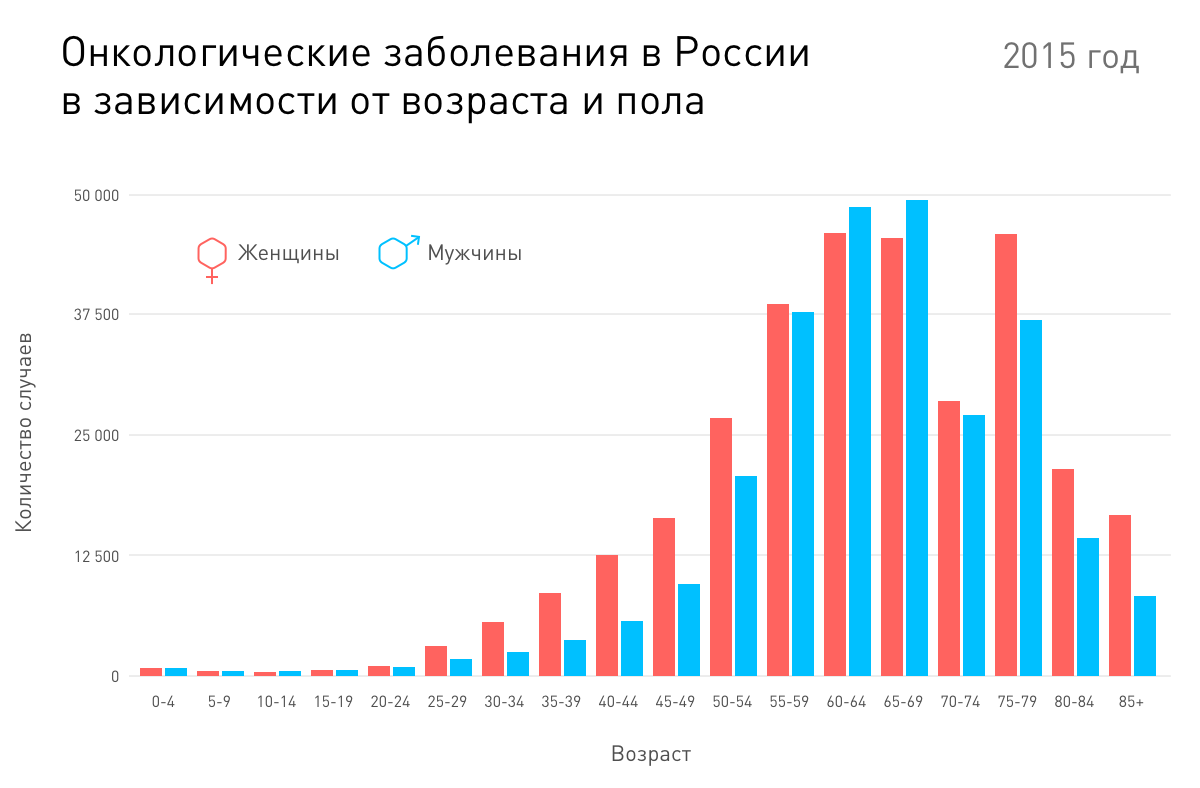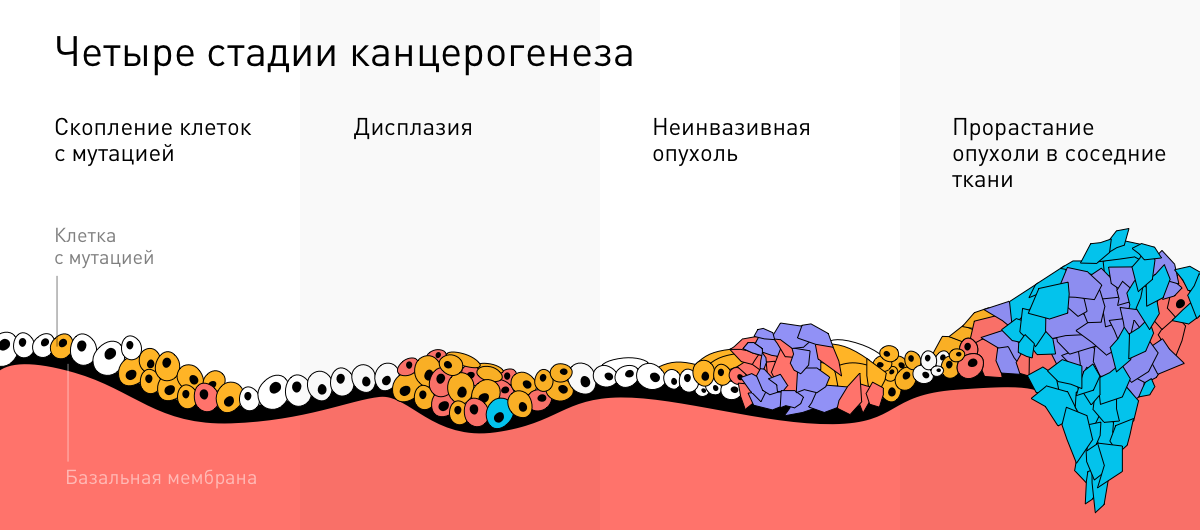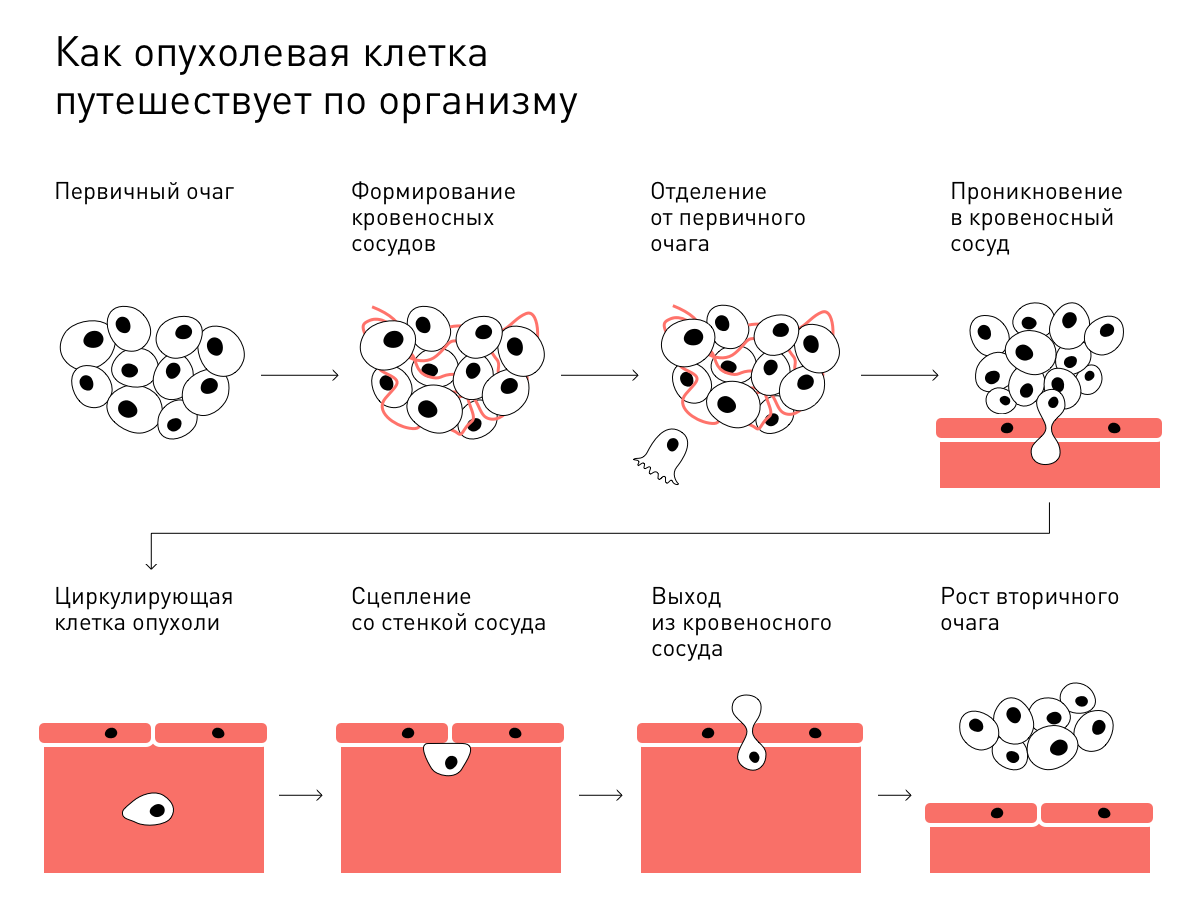Everybody heard about cancer anyway. Someone saw messages on social networks, someone helped their relatives and friends to survive this disease, and someone came face to face with it.
In any case, the cancer is scary. Most fears arise from misconceptions about the disease or simply ignorance. We in the
Atlas believe that knowledge is power, so we prepared a series of articles about the cancer: how it is formed, whether it can be prevented, and how to build a treatment process.
Today we tell what cancer is, how it develops, and why it is so hard to beat.
 Illustrations by Michael Kowalski
Illustrations by Michael KowalskiBefore we talk about the mechanism of the formation of tumors, let's understand a little about the terminology and recall how healthy cells and tissues of the body are updated.
Why is cancer so called
What patients call cancer means, in the language of medicine, an oncological disease or a malignant tumor. A tumor, neoplasia or neoplasm is a collection of atypical cells that divide uncontrollably and refuse to die.
The ancient Greek physician and philosopher Hippocrates was one of the first to describe malignant neoplasms. In his writings, he gave them the name karkinos, which in Greek means “cancer”: in the section, large tumors reminded him of crabs. Later, the Roman physician Cornelius Celsus translated the term into Latin - so the modern name cancer appeared. Another Roman physician and surgeon, Claudius Galen, described benign tumors with the word oncos. Today, oncology is a science that studies the mechanism of the formation of benign and malignant tumors, methods of their prevention and treatment principles.

The English name for all malignant tumors of cancer in Russian is translated as "cancer." In this sense, the term can be used in ordinary life, but doctors call only carcinoma "cancer" - a malignant tumor from epithelial tissue that lines the surface of the body, mucous membranes and cavities of internal organs, and also forms the majority of glands.
In addition to carcinoma, malignant tumors include sarcoma, melanoma, leukemia and lymphoma. Sarcoma is a malignant tumor of connective tissue. The connective tissue includes muscles, ligaments, cartilage, joints, bones, tendons, and deeper layers of the skin. Melanoma is a malignant tumor of melanocytes (skin cells). Leukemia or leukemia is a malignant neoplasm of hematopoietic tissue, and lymphoma is lymphatic.
How healthy cells and tissues are updated
All human organs and tissues are made up of cells. They have the same DNA, but take different forms and perform different functions. Some cells fight with bacteria, the second carry nutrients, others protect us from environmental exposure, organs and tissues are made of others. At the same time, almost all cells are renewed in order for the human body to grow, function and recover after damage.
Cell renewal is regulated by growth factors. These are proteins that bind to receptors on the cell membrane and stimulate the process of division. When a new cell is separated from its parent cell, a cascade of reactions starts in it, and it receives a specialization — it differentiates. After differentiation, only those genes that determine its shape and purpose are active in the cell. We can say that now the cell has a personalized instruction, what and how to do.
All fabrics are updated at different speeds. The cells of the central nervous system and the lens of the eye do not divide at all, and the epithelium cells of the small intestine completely change every 4–5 days. Tissues that are constantly updated contain a layer of stem cells. These cells have no specialization, but can only divide and create either their copy without specialization, or a differentiated cell of the tissue in which they are located.
New cells replace damaged old ones. The damaged cell “understands” that it no longer benefits the body, and it starts the death program - apoptosis: the cell commits voluntary suicide and gives way to a healthy one.

How a cell becomes malignant
During division or due to exposure to DNA damaging compounds, approximately 10 thousand errors occur per day in the cell genome. But our body can deal with them. Special enzymes repair breakdowns or launch an apoptosis program. If the change is left without repair, a mutation is preserved in the DNA chain.
A mutation is a change in DNA that is transmitted to other cells. Mutations are hereditary and somatic. Hereditary mutations occur only in germ cells and are passed on to the next generation.
Much more often mutations occur in other cells. Somatic mutations occur independently of each other in different cells of the body and are not inherited. Some factors significantly increase the frequency of somatic mutations. Cigarette smoke, ultraviolet radiation, radiation and retroviruses are powerful mutagens that can cause mutations in DNA.
When a cell with a mutation divides, the defective DNA is doubled and transferred to the new cell. If another mutation occurs in it, it is added to the existing one. Thus, somatic mutations accumulate in different cells of the body throughout life. This explains the aging of a person and the formation of malignant tumors. By the way, they are closely related: with age, the risk of developing a malignant tumor increases.
 Statistics Moscow them. P.A. Herzen
Statistics Moscow them. P.A. HerzenWhat mutations lead to cancer
Imagine that several mutations happened in one cell. The first one touched the genes that are responsible for the division, and the second - violated the apoptosis triggering mechanism. If these two mutations meet, then we get a cell that is constantly dividing and refuses to die.
Tumor suppressor genes and proto-oncogenes are genes that regulate division, differentiation and apoptosis. A healthy cell uses these genes to determine what it is to become, what functions to perform and when to die. When these genes are damaged, the cell does not have access to the instructions, and it becomes uncontrollable.

Today, about 40 proto-oncogenes are known, and 14 of them are associated with a high risk of tumor development. As an example, ERBB2 (HER-2) is often mutated in breast cancer, KRAS in pancreatic and colon cancer, and BRAF in melanoma.
The most famous tumor suppression gene is BRCA1. Mutations in this gene increase the risk of developing breast and ovarian cancer. Another well-known suppressor gene, TP53: mutations in it are detected in half of the cancer cases.
How does a malignant tumor develop?
Immortal cells continue to divide - and the tumor grows. The accumulation of cells develops into dysplasia - a neoplasm that is not typical for tissue. A non-invasive tumor or cancer in situ means that the tumor has not yet grown through the thin boundary between epithelial and connective tissue (basement membrane). This stage is characterized by equilibrium, which we will discuss in more detail later. Disturbance of the basement membrane is the first sign of a malignant process.
 nccs.com
nccs.comA malignant tumor cannot grow further until it has access to nutrients. Therefore, tumor cells secrete various growth factors, but the most important of them is vascular endothelial growth factor (VEGF). It stimulates the formation of a network of capillaries through which cells gain access to nutrients. Now the tumor can grow into the surrounding tissues and destroy them.
In the malignant cell, DNA damage continues to occur, but they are not restored. A cell spends all its resources on endless division. Due to constant mutations in the tumor, cells appear with a variety of shapes and properties.

The body is trying to fight the tumor, and the environmental conditions for the malignant cells are constantly changing. Only those malignant cells that can resist change survive and divide. It can be said that among the cells of a malignant tumor, natural selection occurs.
Go
As fission develops, tumor stem cells appear in the neoplasm. They can replicate themselves and produce normal cells of a malignant neoplasm. Tumor stem cells are difficult to destroy during treatment, leading to relapse.
Over time, as a result of the selection, a cell appears able to detach from the tumor, find a suitable place for the secondary focus to begin to divide in the new environment. This forms metastasis.
Not all tumors consist of malignant cells. Benign cells differ in that they partially or completely retain their specialization. They slowly divide, accurately replicate DNA and remain similar to the cells of the original tissue. DNA repair continues to work in a benign tumor, such a number of mutations and natural selection do not occur, so this tumor is easily amenable to surgical treatment. But due to additional mutations, cells of benign tumors can turn into malignant ones. For example, moles may degenerate into melanoma (a malignant neoplasm of the skin) due to ultraviolet exposure.
Why immunity can not cope with a malignant tumor
Another feature of malignant tumors is the reaction of the immune system to them. There are three stages of the immune system response:
Elimination Damaged cells express tumor antigens on their surface, to which the main guards of the immune system, macrophages and lymphocytes, react. They find and destroy the enemy. At this stage, the tumor cannot grow into the surrounding tissues, because it is called non-invasive or in situ tumor (in situ).
Equilibrium. Some cells begin to mask - to synthesize fewer antigens. The immune system cannot find and destroy them, but recognizes other malignant cells. At the stage of equilibrium, the immune system cannot cope with the tumor completely, but limits its growth. This condition can last for years and does not manifest itself.
Impotence. Due to genetic instability, cells with different mutations are constantly born in the tumor. Therefore, sooner or later, immunosuppressive cells appear that reflect the attack of the cells of the immune system and suppress the immune system.

How does metastasis appear
The secondary focus of growth of a malignant tumor is called metastasis. Metastasis is the superpower of a malignant tumor; complex process for which the tumor is preparing for a long time.
First, malignant cells secrete special bubbles - exosomes. They travel all over the body, find a tissue suitable for metastasis and prepare it for the arrival of cancer cells. So in normal tissue an attractive niche is formed, where malignant cells can settle and begin to divide. Sometimes cancer cells resemble self-taught artificial intelligence, but this is not the case.

Also, some cells are able to secrete special signaling molecules that reprogram macrophages. Some of them cease to struggle and begin to perceive the tumor as damaged tissue. Such macrophages secrete various growth factors that help tumor cells to divide. In this stage, the immune cells are divided into two opposite camps: some continue to destroy the tumor, while others help it grow. This is a turning point after which the tumor begins to grow and metastasize.
A malignant cell cannot simply detach from a tumor and begin to travel around the body. It must be able to detach from other cells, penetrate into the depths of surrounding tissues, and survive after it enters the blood and lymph vessels. To do this, malignant cells secrete special substances that allow them to move, destroy cells of other tissues and hide from the immune system.
Together with lymph, malignant cells enter the lymph nodes. Lymphocytes in them are trying to stop and destroy the enemy so that he does not pass on. Due to the inflammatory process, the lymph nodes are enlarged, and most cancer cells die. Surviving cells can settle in the tissue of the lymph node and give metastasis. As a rule, cells of a malignant tumor first infect the nearest lymph nodes and only then reach distant ones.
Malignant cells continue to search for prepared tissue as they move through the body. Most of them die in an unfamiliar environment, so the search can take a long time. But sooner or later a cell appears capable of escaping from the blood or lymphatic vessel, attaching itself to the prepared tissue and starting to divide in a new place. This forms a secondary focus or metastasis.

A schematic depiction of a malignant tumor cell that can give metastasis.
Researchgate.netDifferent types of malignant tumors have favorite sites for metastasis. For example, breast cancer often metastasizes to the lungs, liver, bones and brain. The name of the disease is always associated with the primary tumor and does not depend on the sites of metastasis.
What does the fourth stage of cancer mean and why is it the most dangerous
For diagnosis, it is extremely important to assess the type, extent, differentiation and growth rate of a malignant tumor. For this there is an international classification of TNM.
T - tumor (tumor). Next to the letter T can be a number from 0 to 4, which characterizes the prevalence of the primary tumor. T0 - a tumor cannot be determined. The higher the number, the larger the size of the tumor and the likelihood of germination in the surrounding tissue. Tis - designation for non-invasive tumors.
N - nodes (nodes). From 0 to 3. This indicates the absence, presence or prevalence of metastases in regional lymph nodes. If metastasis appears in a distant lymph node, it belongs to criterion M.
M - metastases (metastases). Distant metastases either are - M1, or they are not - M0.
If any of the components of the system cannot be measured, then an X is placed next to the letter.
 Epomedicine.com
Epomedicine.comTNM classification allows to determine the stage of the tumor process.
The first stage is a small tumor at the site of occurrence. The second stage is an enlarged tumor, which sprouted into the surrounding tissues and possibly metastasized to the nearest lymph nodes. The third stage is a rather large tumor that metastasizes to the nearest lymph nodes. The fourth stage is a tumor with metastases in other organs and tissues.
As a rule, it is impossible to completely cure the tumor in the fourth stage: drug therapy can only slow the course of the disease. Palliative care is provided to such patients, its task is to improve the patient's quality of life.
How to fight cancer
A malignant tumor seems to be a monster that uses all the forces and functions of the body for its own benefit. But do not forget that the appearance of this monster can be prevented if you know about your risks and preventive measures.

In addition to prevention, it is important to undergo regular examinations in order to diagnose a malignant neoplasm at an early stage. Until the tumor has spread to other tissues and organs, it is treatable.
In the next article, the
Atlas will explain in detail how to reduce the risks of developing malignant neoplasms, as well as give instructions on when and what tests to take in order to protect themselves.
In the meantime, we offer to take a
test from the Cancer Prevention Foundation. Based on its results, it is possible to roughly estimate the risk of developing malignant tumors.